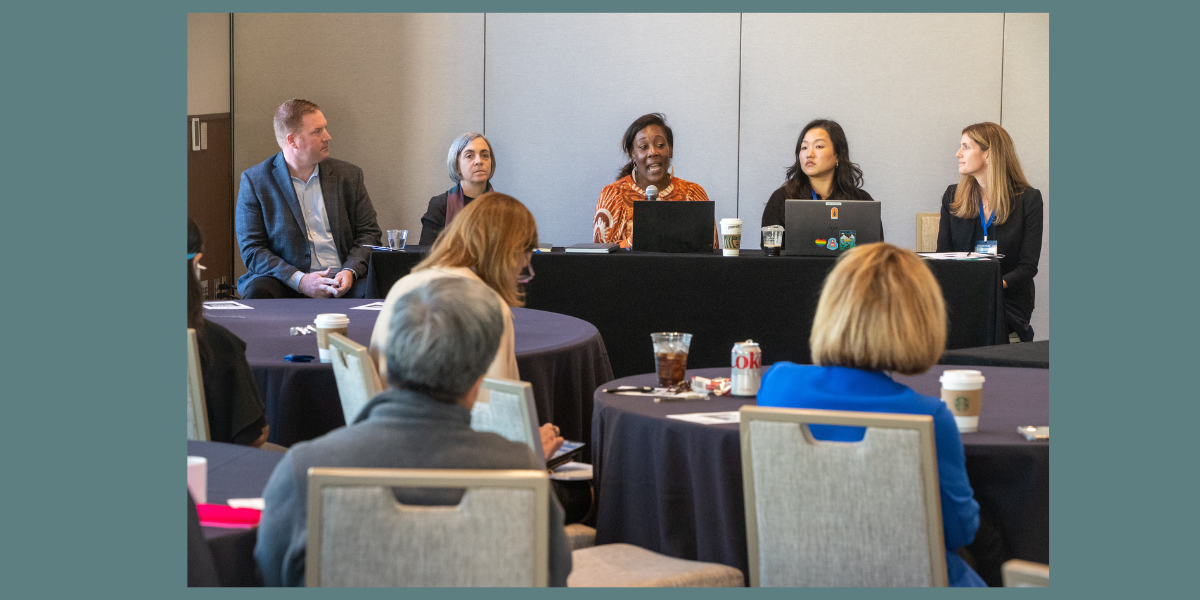
Technology panel discussion at the 2022 GIA conference. Left to right: Stephen Ewell, Catherine DesRoches, Kameron Mims-Jones, Megan Hee Soo Park, and Laura Rath.
By creating a seamless integration of healthcare and social services, Archstone Foundation believes technology is key to improving the health of older adults at scale. Technology can enable better health care, reduce racial and ethnic disparities, and improve health and well-being. We also have a firm belief in partnerships and learning from others.
Those two beliefs came together last month, when Archstone Foundation led a technology-focused session with nationally recognized leaders in the field at the Grantmakers in Aging (GIA) annual conference. They have also converged in our decision to work with a consultant to assess the range of opportunities for funding technological innovations that could improve the health and well-being of older Californians and their caregivers
Engaging in Critical Conversations at GIA
Our session at the GIA meeting in Scottsdale, Arizona, was moderated by Archstone Foundation Vice President of Programs, Laura Rath, PhD, MSG. The panel included Stephen Ewell, MBA MSITS, executive director of the Consumer Technology Association Foundation; Kameron Mims-Jones, MSW, a policy advocate at Nourish California; Megan Hee Soo Park, MSG, a program manager at Front Porch; and Catherine DesRoches, PhD, executive director of OpenNotes.
To start, panelists discussed how they are utilizing technology to cross the digital divide, empower transparent communication in healthcare, and share patient information across health and social service settings and how doing these things can reduce racial and ethnic health disparities. The panel then opened the room to questions and discussed the ways the field of philanthropy can apply technology to aging.
Several important themes emerged. Among them:
- Older adults disproportionately lack access to technology. Park described how Front Porch’s Lighthouse Project provides internet accessibility and digital inclusion to improve the health and well-being for those in affordable housing.
- Too little technology is focused on older adults, missing important opportunities to better help them and their caregivers. Dr. DesRoches shared the challenges OpenNotes faced in helping patients and their caregivers understand more about their care, because electronic health records are not designed with patients in mind. For example, doctors often use abbreviations many don’t understand -- not only BMI, MRI, and PTSD, which are relatively common, but such unfamiliar (and potentially misleading) shorthand as SOB for shortness of breath.
- Technology must be accompanied by increased transparency and guidance. Ms. Mims-Jones illustrated how Nourish California shared authoritative guidance from the State of California (SHIG 2.0), which clarified state and federal laws to allow for the exchange of patient information between healthcare providers and providers of nutrition and food services.
Our discussion also highlighted the importance of integrating justice, equity, diversity, and inclusion into all aspects of funding and supporting technology-based projects. Many older adults lack access to technology because of insufficient infrastructure where they live, reducing their potential ability to benefit from many technological initiatives. Additionally, training in technology needs to be culturally competent to reach all older adults.
For technology investments to be successful, the technology’s design must place older adults at the center. Technology cannot become a barrier to making connections. Instead, it must benefit older adults in meaningful ways – and starting with a person-centric design philosophy is key to achieving that goal.
Building Our Technology Strategy
Learning from experts, community leaders, and other grantmakers is essential to the Foundation’s approach to investing in technology. We are currently supporting projects that promote the adoption of technologies, facilitate teamwork between healthcare and social services providers, and empower older adults and their families to direct their care. As we learn more about technology through our partnerships, we will strive to continue investing in improving the health and well-being of older adults in California.
To this end, we have recently engaged with Manatt Health Strategies to develop a Strategic Landscape, Opportunities Assessment and Funding Priorities Report. The goal is to provide an overview of the data exchange landscape in California as it relates to older people in the state and identify where Foundation investments would have maximum impact. Manatt has completed a review of funding opportunities, including a scan of the field, and conducted interviews with ten experts. With input from those interviews, Manatt hosted two workshops to continue gathering feedback and identify funding priorities for the Foundation. The initial results suggest that we may want to focus our Technology funding in one or more of these three areas: partnerships and collaboration, research and evaluation, and funding for pilot programs – and that all of those should have an explicit focus on advancing equity and reducing health disparities. We’ll share more information about our emerging strategy early next year.


